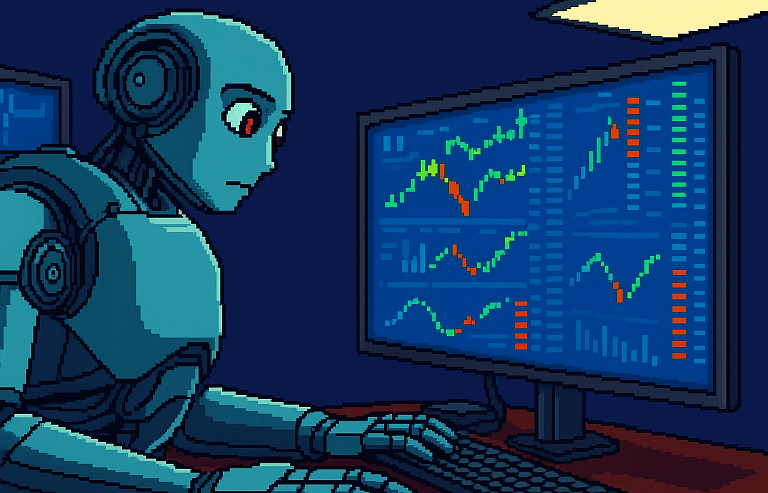Artificial Intelligence (AI) trading represents one of the most significant technological advances in modern finance, fundamentally transforming how investment decisions are made and executed. As financial markets become increasingly complex and data-driven, AI trading systems offer unprecedented capabilities to analyze market patterns, execute trades, and manage risk with speed and precision that human traders simply cannot match. For beginners, understanding AI trading can seem daunting, but this guide breaks it down into clear, digestible concepts to help you grasp its fundamentals, benefits, and risks.
Understanding AI Trading
AI trading, also known as algorithmic or automated trading, involves using computer programs powered by artificial intelligence to make trading decisions and execute transactions in financial markets. These systems leverage machine learning (a subset of AI) algorithms, natural language processing, and advanced statistical models to analyze vast amounts of historical market data, news sentiment, economic indicators, and other market signals. These models learn from past trends to identify trading opportunities, and execute trades without human intervention.
Unlike traditional trading methods that rely on human intuition and manual analysis, AI trading systems can process thousands of data points simultaneously, including price movements, trading volumes, news sentiment, economic indicators, and even social media trends. This comprehensive analysis enables AI systems to make informed trading decisions in milliseconds, capitalizing on market opportunities that might be missed by human traders.
AI trading systems generally comprise three primary components:
Data Feed: The system collects and processes large amounts of market data, including prices, trading volumes, and economic indicators.
Algorithm: The machine learning algorithm analyzes the data, identifies patterns, and makes predictions about future market movements.
Trade Execution: The system executes trades based on the algorithm’s predictions, either automatically or with human oversight.
Types of AI Trading
Rule-Based Systems: These systems follow predefined rules and execute trades based on specific conditions.
Machine Learning Systems: These systems utilize machine learning algorithms to examine data and forecast future market trends.
Hybrid Systems: These systems merge rule-based and machine learning techniques to develop a more resilient trading system.
Types of AI Trading Strategies
AI trading encompasses several distinct strategies, each designed to capitalize on different market conditions and opportunities. High-frequency trading represents one of the most well-known applications, where AI systems execute thousands of trades per second to profit from tiny price discrepancies. These strategies require sophisticated technology infrastructure and are primarily used by institutional investors.
Momentum trading strategies use AI to identify stocks or assets showing strong directional movement and ride these trends for profit. The AI analyzes technical indicators, volume patterns, and market sentiment to determine when to enter and exit positions. Conversely, mean reversion strategies bet that prices will return to their historical averages, with AI systems identifying overbought or oversold conditions.
Arbitrage strategies leverage AI’s ability to quickly identify price differences for the same asset across different markets or exchanges. The system operates by purchasing at a low price in one market while selling at a higher price in another, thereby securing risk-free profits. Trading strategies that rely on news utilize natural language processing to evaluate financial news and the sentiment on social media, executing trades according to the anticipated market effects of breaking news or events.
Benefits of AI Trading
Speed: AI trading systems are capable of analyzing data and executing trades significantly faster than humans, which enables a quicker reaction to market fluctuations.
Accuracy: Machine learning algorithms excel at recognizing patterns and making predictions with remarkable accuracy, thereby minimizing the chances of human error.
Emotionless Decision-Making: AI trading systems make decisions based on data and algorithms, eliminating the influence of emotions and biases.
Backtesting & Optimization: Before risking real money, AI traders can backtest strategies on historical data to see how they would have performed.
Scalability: AI trading systems can handle large amounts of data and execute multiple trades simultaneously, making them ideal for high-frequency trading.
24/7 Operation: AI trading systems can function continuously, keeping an eye on the markets and executing trades even when humans are unavailable.
Risks and Limitations
Even with its benefits, AI trading comes with considerable risks that users need to be aware of. Technical failures can lead to major losses, especially when systems break down in unstable market situations. Flash crashes, which are occasionally linked to algorithmic trading, show how AI systems can increase market volatility in specific scenarios.
Market conditions can change rapidly, and AI models trained on historical data may not perform well in unprecedented situations. The 2020 pandemic-induced market crash, for example, created conditions that many AI trading systems had never encountered, leading to unexpected losses for some automated strategies.
Over-optimization presents another risk, where AI systems become too closely fitted to historical data and fail to adapt to new market conditions. Additionally, the increasing prevalence of AI trading means that markets may become less predictable as more sophisticated systems compete against each other.
Getting Started with AI Trading
For beginners interested in AI trading, starting with education and research is essential. Many online platforms,like TradeStation or MetaTrader, now offer AI-powered trading tools and robo-advisors that provide exposure to algorithmic strategies without requiring extensive technical knowledge. These platforms typically offer user-friendly interfaces and educational resources to help newcomers understand the technology.
Before committing significant capital, consider starting with paper trading or small amounts to understand how AI trading systems perform in real market conditions. Do also remember, there is no guaranteed profits. It’s also crucial to understand the fees associated with AI trading platforms and ensure that any system you choose aligns with your investment goals and risk tolerance.
Even with AI, trading requires oversight. Regular monitoring and adjustments might be required as the system’s performance may get dislocated through different market conditions.
AI trading represents a powerful tool that’s reshaping the investment landscape, offering both opportunities and challenges for modern investors. While the technology continues to evolve rapidly, understanding its fundamentals provides a solid foundation for anyone looking to leverage artificial intelligence in their trading strategy.
Would you try AI trading? Let us know in the comments!

